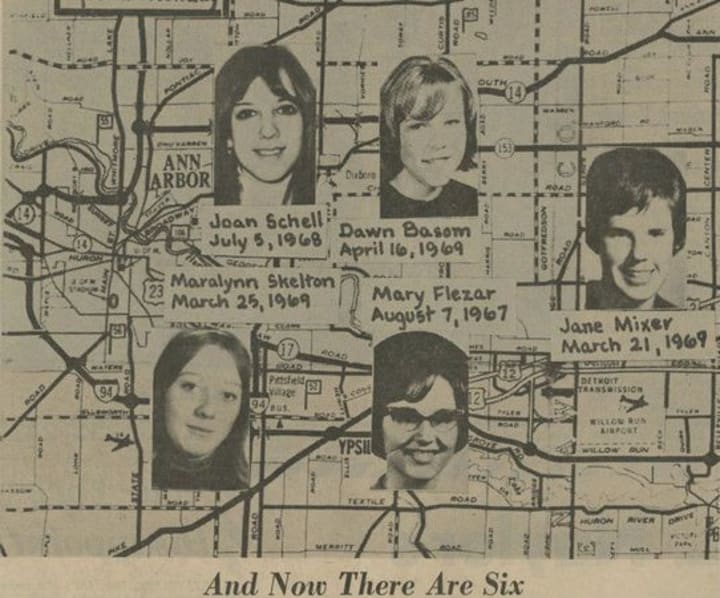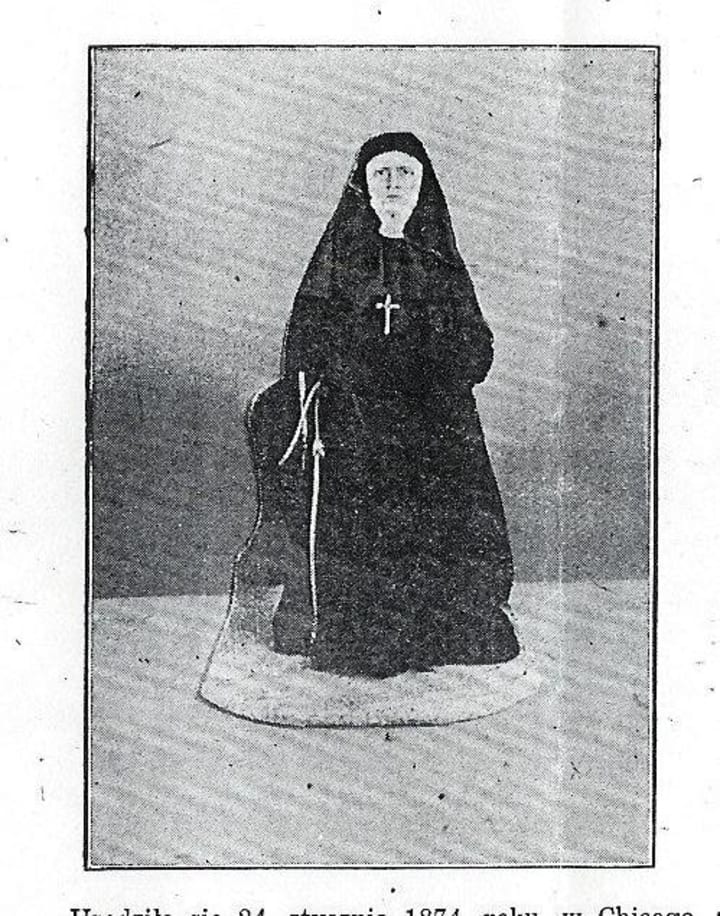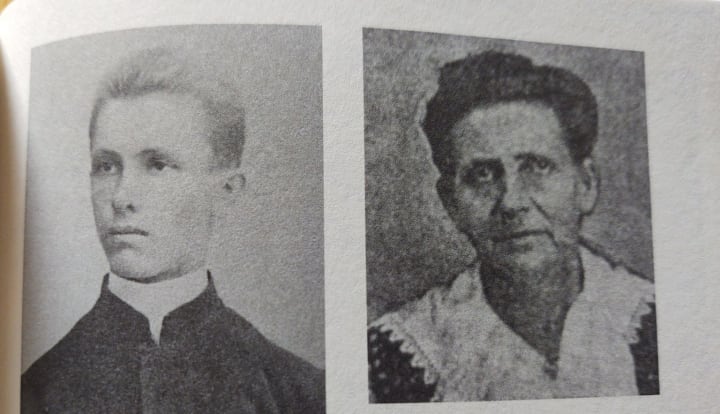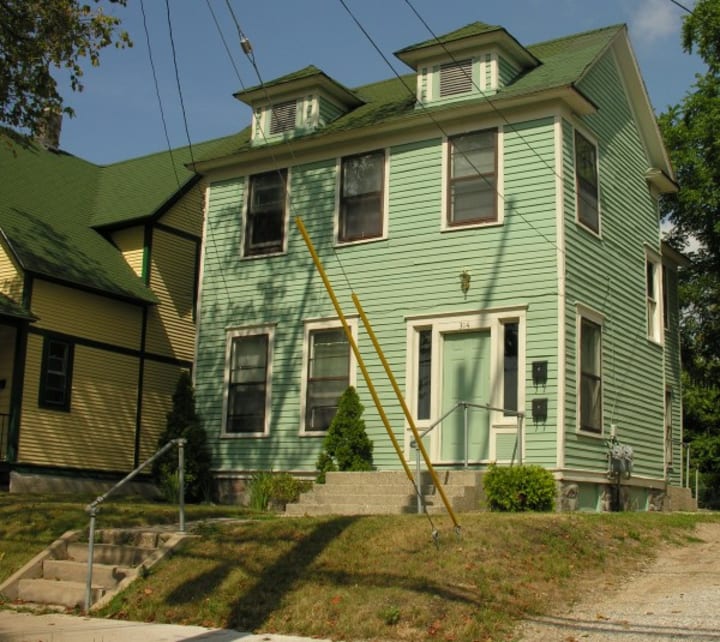5 Freaky Michigan Murders
Murder and mayhem in the Mitten State

As the leaves turn a deep shade of crimson, so, too, do Michigan's streets.
Well, not really. But this article is all about murder and mayhem in the Mitten State.
I'm a life-long Michigander. West Michigan, loud 'n proud! Well, maybe not proud, but definitely loud.
Truth be told, all areas of Michigan have their mysteries. We've made the news quite a bit in the last couple of years for some seriously disturbing cases. But our history is riddled with chilling stories, both solved and unsolved.
The five cases that I picked for this article are from various decades, but the victims are all women. Although men are statistically murdered at higher rates in Michigan, the more sensationalized cases revolve around gruesome murders enacted against women. These cases are somehow more disturbing, more grotesque, more devastating to communities. And, when they go unsolved, they generate a lot of concern.
Before I go too far into socioeconomic concepts regarding the psychology of murder against women, let's talk about five horrific murders that happened right here in the Mitten State.
Jane Mixer

Jane Mixer's story is one I was unfamiliar with until I heard about it on the Bitter Endings podcast. Jane's story is still one with plenty of mystery despite a suspect - Gary Leiterman - being convicted of her murder in 2005.
Back in the late 1960s, Ann Arbor was rocked by a series of murders that left police scratching their heads and young women terrified of going out on their own.
Jane Louise Mixer was a 23-year-old University of Michigan (UofM) student who was simply looking for a ride home to Muskegon, which is literally on the opposite side of the state from Ann Arbor. Jane was recently engaged and planning to move to New York, and was heading home to tell the parents the good news. She had posted a note on her college's bulletin board looking for a ride. According to her father, Jane was hitching a ride with David Johnson, who had replied to her ad. A phone book with "Mixer" and "Muskegon" was later found on campus, the words presumably written by Jane's killer.
On March 20, 1969, Jane disappeared.
The following morning, Jane's body was discovered on top of a grave in Denton Cemetery, which is in Van Buren Township. She was fully clothed, and a copy of Catch-22 was placed at her side. She had been shot in the head twice with a .22 caliber then garroted with a nylon stocking that did not belong to her. The forensic pathologist asserted that Jane had been murdered around 3 a.m. and had not been sexually assaulted. Also, it was determined that she had been killed elsewhere and dumped at the cemetery after death.
Oddly enough, Jane's tights had been lowered to expose her thighs and sanitary napkin. Given the fact that she had been garroted with a stranger's nylon and had been found near to the sites whereJoan Schell and Mary Terese Fleszar (victims of the Co-Ed Killer John Norman Collins, who is currently incarcerated at Marquette Branch Prison after receiving a life sentence in August of 1970) were dumped.

However, Collins was never charged with Jane's murder. That charge fell on Gary Earl Leiterman. Collins raped and brutalized his victims prior to dumping their bodies in the Ann Arbor area; Leiterman's modus operandi was different. Leiterman carefully covered Jane's body with her yellow raincoat.
Leiterman was charged based on DNA evidence. 62-year-old Leiterman was visited by a Sergeant in his Gobles home in 2004 and stated, "I did not do this" when accused of killing Jane.
In the late 1960s, Leiterman worked as a pharmaceutical sales rep in the Ann Arbor area. He was an unlikely murderer on the surface, but beneath lurked something dark. He was arrested in 2001 for passing a forged prescription and was found to have stashed prescription blanks in his car, stolen from the Kalamazoo hospital where he worked. Leiterman was also charged with illegally obtaining Vicodin, Lorcet, and other painkillers. He apparently became addicted to painkillers after experiencing kidney stones and pled guilty when he entered into drug rehab.
Because Leiterman was a convicted felon, he was required to provide DNA. The state law requiring a DNA swab took effect just three days prior to Leiterman's conviction. This is what led to his murder arrest.
In his home, police found disturbing photos of a 16-year-old South Korean foreign exchange student who had lived in the Leitermans' home. The girl had been drugged into unconsciousness, lying on the Leitermans' bed with her genitals exposed. This photo was eerily similar to Jane Mixer's crime scene. Prior to his murder trial, Leiterman pled guilty to possessing child pornography.
The case was difficult to prosecute, especially given that it had happened 36 years prior. However, handwriting analysis confirmed that the writing in the phone book matched Leiterman's penmanship. Leiterman's former roommate also testified to Leiterman owning a .22 caliber pistol and having kept a close record of the Co-Ed murders. The defense asserted that contamination at the crime lab handling the DNA evidence resulted in a mess-up. But the jury still found Leiterman guilty of Jane Mixer's murder.
Jane's 90-year-old father was present in the courtroom, and her loved ones erupted into sobs when the verdict was read. Life in prison. Leiterman always maintained his innocence, and some still believe that the real killer got away with Jane's murder.
Ashley Young

This case is a recent one that is nothing short of horrific. And, for me, it hits extremely close to home. I'm a native of Grand Rapids, and I know this town extremely well. I know that most people here are decent enough, but I also know it has a seedy underbelly full of people who are manipulative and untrustworthy. Unfortunately, Ashley found herself in the company of one such person - Jared Chance, age 29.
Ashley Young, 31, hailed from Kalamazoo. On the evening of November 29, 2018, Ashley was seen leaving Mulligan's Pub in Eastown (a district in Grand Rapids, on its east side) with Chance. On December 2, her dismembered torso was discovered in the basement of Chance's rental home in the 900 block of Franklin Street SE. Her other body parts were found on the landing of Chance's upper level apartment.
Chance's parents - James and Barbara Chance - were later issued a prosecutor's investigative subpoena and charged as an accessory after the fact for their involvement in the murder.
On November 28, Ashley's mother, Kristine Young of Grand Haven, grew concerned that she had not heard from her daughter, who usually responded quickly to her mother's calls and texts. Kristine texted Ashley to say that if she did not reply, Kristine was going to call the police. She reported her daughter missing on November 29 and even drove into Grand Rapids and confronted Chance about Ashley's whereabouts. Chance confessed that he and Ashley had gone to Mulligan's and to the Hookah Lounge. Kristine went to Mulligan's, and a managed showed her video surveillance of Ashley and Chance at the pub in the early morning hours.
Chance's parents and brother, Konrad, 27, drove to Grand Rapids on December 1; they brought him back to their Holland home. Chance brought with him a cardboard box stuffed with a black garbage bag and a mop. Ashley's DNA was later discovered by authorities in the parents' Honda CR-V.

The following day (December 2), James Chance took Jared Chance back to Grand Rapids, to the Grand Rapids Police Headquarters. Chance's defense lawyer, Andrew Rodenhouse, said that GRPD told the father to contact Kalamazoo PD since they were handling the missing person complaint. James Chance demanded a lawyer for his son before any police could question him, so the officers were unable to talk to Jared Chance. The Chances were in and out of the building in just a couple of minutes. Jared Chance then gathered up the box and its items and took them back inside his residence.
That same day, GRPD responded to a call from Chance's neighbor, Mario Nelson, who also lived in the two-unit rental, in the bottom unit. Nelson saw a blood-covered tarp in the basement after noticing a strong scent coming from that area. Police found Ashley's torso down there but had no way of identifying her at that time. Ashley's loved ones feared that the worst had happened to Ashley.

Later that evening, when Chance was sleeping, police ordered him out of the home so that they could enact their search warrant. That was when they found Ashley's other body parts stuffed in the box, sitting on the landing outside of Chance's front door. Chance was then charged with mutilation of a dead body and concealing a death. But the question remained: Had Chance killed Ashley? And, if he did, why?
On December 5, GRPD took out a search warrant on the Chances' home in Holland. There, they found a Skil reciprocating saw stashed beneath a couch; it was covered in blood and, as testing confirmed, human tissues. This was confirmed on December 7 when DNA testing revealed that the torso found in the basement indeed belonged to Ashley. Finally, on December 12, Chance's parents were charged. Police asserted that the parents knew their son had cut up Ashley's body but never disclosed this information while under questioning. On January 3, Chance was charged with open murder and four counts of tampering with evidence. Chance had told others he knew how to kill someone and seemed obsessed with a small firearm that he once pointed at his brother.
Speaking of Konrad Chance, he testified that his brother looked highly disturbed when Konrad and his parents picked Chance up in GR. He saw Chance put the box into the vehicle, but no one ever asked what was in it. Mr. Chance was required to stand trial, and Mrs. Chance ended up having her case bound over as well.
Jared Chance's probably cause hearing on January 11, 2019 revealed that police believe Chance shot Ashley in her head before dismembering her corpse. Forensic pathologist David Start testified that the cause of death was officially homicide by unspecified means.
Although Chance was sentenced to 100-200 years in prison for his crime and an appeals court has upheld the conviction, Ashley's loved ones wish to keep her memory alive. They are also trying to locate the rest of Ashley's missing remains. The family would like for anyone who is interested to contribute to the Ashley Young Memorial Account at Lake Michigan Credit Union.
Sister Mary Janina Mezek

The first I heard of this old case was last year, in an episode of Deadly Women. That's right; the *alleged* perpetrator of this crime was a woman.
Sister Mary Janina 'Josephine' Mezek has become known as 'The Nun In the Basement' due to what happened to her on August 3, 1907 when she was just 34 years old.
Sister Mary Janina was a well-loved nun who went missing from the Holy Rosary Catholic Church. As author Mardi Link expertly details in the book Isadore's Secret: Sin, Murder, and a Confession in a Northern Michigan Town, Sister Mary Janina (pronounced Ya-nee-nah) were not discovered until 1918, when they were unceremoniously unearthed from the basement cellar of Holy Rosary Catholic Church in a small Northern Michigan town called Isadore. The church's new priest, Father Edward Podlaszewski, wanted to build a more fashionable new church. Bishop Edward Kozlowski had warned Father Podlaszewski that the body of a missing nun was probably buried in the basement but that the church did not want to attract any negative attention for it. Father Podlaszewski shrugged it off and went ahead with building plans.
Father Podlaszewski asked sexton Jacob Flees to help him go into the basement, just to make sure. They took a couple of lanterns and a potato fork that November night and crept into the dank dirt basement cellar beneath the wooden clapboard floors of the church. If the rumors were true, the nun's body would have to be removed prior to demolition on the old church so as to avoid a serious scandal.

But scandal was exactly what the priest and the sexton unearthed that night. What was most scandalous was the presence of a fetal skeleton cradled inside Sister Janina's remains.
Horrified, Father Podlaszewski instructed Flees to bury the remains inside of a crate beneath a massive cross located in the church's cemetery. The priest instructed Flees to keep quiet on the matter - and he did, for a while. He did not even tell his dear wife, Mary.

Isadore was a Polish town to its core. Its citizens had immigrated from Poland due to overpopulation in that country at the time, not to mention that many desired a good amount of land. Their loyalty to one another was unparalleled, and they were ardently Catholic in their faith. But Father Podlaszewski went ahead and confided in the school's head nun, Sister Superior Hillaria, and assistant Felician nun named Sister Gastone. So, word did spread.
One week after the discovery, Father Podlaszewski was called to the Miller home to answer for why the Millers' teenager daughter, Martha, was pregnant. Martha refused to confess with whom she had sexual relations, but given that she was a housekeeper at the Holy Rosary Church, there was suspicion that she and Father Podlaszewski were getting it on. Martha was sent away to quietly have the baby and was brought home six weeks afterward - without the baby, of course.
When she returned on January 24, 1919, Father Podlaszewski confided in Martha about the nun in the basement. Martha remembered from her childhood - as a student at the school - the disappearance of a nun named Sister Janina. Many assumed Sister Janina, who was considered an outsider in the community despite her Polish heritage, had up and left the church.
Martha has become more confident after being away for six weeks and confided in her father everything she knew about Sister Janina as well as the fact that Father Podlaszewski was the man who had fathered her own child. Joseph Miller promptly phoned the sheriff, and Father Podlaszewski was sent to trial before his Catholic peers in Detroit, where his punishment was determined.
But he wasn't the only priest at Holy Rosary to have engaged in sexual intercourse with a woman and get her pregnant. This is just the beginning of the story.

Friday, August 23, 1907 was baking day in Isadore. Each day of the week had an assigned task. And, for Father Andrew Bieniawski, his sister, Susan, and a chore boy named Gruba, their task was to go fishing at Carp Lake (now called Lake Leelanau).
That summer, the three school nuns decided to remain on campus as opposed to going back to their Felician Home for Nuns in Detroit. All three had contracted tuberculosis (TB) and were finding that recovering in Northern Michigan was preferable. Sister Janina was significantly younger than Sister Josephine and Sister Angelina. Sister Janina's task for that day was to retrieve some paper flowers from the basement cellar, then to return to her room to rest.
Housekeeper Stella was busy tending to her baking that day and didn't have time for silly decorations. She was prone to scoffing at Sister Janina's ways and would talk down to - and about - her. She is quoted as having said, “That one is no good as a nun. Her duties go unfinished.” She was particularly displeased that Father Andrew and Dr. Fralick were always tending to Sister Janina in her room. To Stella, it wasn't just about Janina getting all that attention, it was improper and against her extremely conservative Polish Catholic views. Although some thought Stella was jealous of Father Andrew's particularly close attention to Sister Janina.
When it became obvious that Sister Janina was missing, her fellow nuns searched the church for her. Sister Janina was known to enjoy hikes in the woods and around the swamp. She would sing as she strolled, seemingly lost in thought.
Father Andrew, upon his return, was highly distressed to learn Sister Janina was missing. He helped launch a massive, community-wide search and even paid a clairvoyant, who wasn't able to give him helpful information. Sheriff Kinnucan joined the search after a week passed.
But Sister Janina was never found. Her brothers never heard from her, and every lead came up empty.
Fast-forward to 1918 again. Investigators determined that Father Andrew could not have been the one to kill Sister Janina since his fishing trip gave him a strong alibi. Stella, however, had absolutely no alibi, and suspicion fell on her, given her known dislike for Sister Janina. Stella was eventually taken from where she had been staying in Manistee to the jail in Leland.
Sheriff Kinnucan went to interrogate Stella, presenting her with Sister Janina's remains. A voice repeatedly said "You killed me. You killed me." The prosecution put a Polish-speaking female investigator named Mary Tylicka in the same cell as Stella, whom she befriended while in there. Tylicka got a confession from Stella:
First I stunned her. Then I went out into the garden and got a spade. I dug a hole under the church, dragged the body to the hole and put it in. As I was trying to cover the head, it would always rise up. I threw two or three shovels of dirt on the head, but each time it rose up. Then I took the backside of the spade and knocked the Sister three times on the head with all my might.
Stella's defense team arrived on May 4th, 1919 and were dismayed to learn about the opposition's interrogation methods. They found Stella in horrible condition, rolling on the floor and making animalistic noises. She was sent to Ann Arbor for a psychiatric evaluation and treatment. The doctor there claimed, after two weeks, that Stella had faked her insanity and was fit to stand trial.
The trial commenced on July 29th, 1919, and the courtroom was jam-packed. Stella's daughter Mary took the stand, as did many from the community who knew of Stella's hatred for Sister Janina. Parishioner Mary Gatzke testified that Stella called Father Andrew a "man with wives" and Sister Janina "a slut".
The defense tried to pin the blame on Dr. Fralick, bringing up a note written that Janina had willingly disappeared and asserting that he had gotten Janina pregnant. However, the judge handling the trial would not allow the note into evidence. The bones were laid out on a table in the courtroom, and the cause of death was ruled to be a skull fracture. A pathologist then testified that the fracture occurred postmortem. Stella was found guilty.
Father Andrew tried to help Stella with appeals, and she was eventually granted parole in 1927. Stella moved to Milwaukee and passed away in 1961 at the ripe old age of 92. A new brick church was erected in 1923 on the site of the old Holy Rosary Church.
Did Stella receive the proper punishment? Did she essentially get away with murder? Was she even guilty? What could have been her motive - jealousy? Who fathered Sister Janina's baby? We may never know.
Allison Burns

Riverside Park is a sprawling public space spanning the northeast side of the Grand River in Grand Rapids. It is normally considered to be a safe place for people to jog, ride their bikes, fish, and play with their kids.
But, on December 22, 2001, it was the scene of a crime.
A 19-year-old woman named Allison Marie Burns was found clinging to life in Riverside Park. She had been severely beaten and left for dead. Unfortunately, she passed away the next day from severe head trauma.
Allison had attended a Grand Rapids Public Schools program for disabled adults called Community Based Occupational Training.
She is now interred in an unmarked grave in Oak Grove Cemetery in Grand Rapids. Her attacker(s) has never been identified, and this homicide case remains cold. Anyone with knowledge of the crime is asked to call Grand Rapids Police Department at 616-456-3604 or Silent Observer at 616-774-2345.
Shelley Speet Mills

Known as the Heritage Hill Bride, Shelley Speet Mills was recently married and living in an apartment at 314 College Ave. NE in Grand Rapids. On September 15, 1970, her mother, Vesta Speet, drove from Holland to have lunch with her 19-year-old daughter. Her blind husband sat in the passenger seat beside Vesta. After pulling up and waiting, Vesta thought it odd that her daughter didn't come out to the car after honking the horn, so Vesta got out and went to the front door.
When Vesta entered the apartment, she found a scene straight out of a horror movie. First, Vesta phoned the police. Then, she called Shelley's husband of three weeks, Lowell band teacher Bill Mills. She had to tell him that his bride of 17 days was splayed out on the kitchen floor, lifeless and covered in blood.

Shelley had been stabbed 32 times - once in the chest, once in the back, and 30 times in the neck. The neck stabbings nearly decapitated her. The weapon - likely a large kitchen knife - was never found. Since DNA testing did not exist back then like it does today, there was no way to determine if the killer left any of their own blood behind, mingled with Shelley's.
Bill was ruled out as a suspect, as he had a solid alibi. But if not Bill, then who? Who would want to harm Shelley, who was not known to have any enemies?
The case went cold, but the murders did not end.


In fact, Shelley's was the start of the Heritage Hill Murders. One year later, 25-year-old student Barbara Larson was found stabbed to death in her mobile home with so many stab wounds to her neck she was nearly decapitated. In May of 1975, 20-year-old Laurel Jean Ellis was found in her apartment at 627 Fountain Street NE with 45 of her 60 stab wounds to the face and neck. She had also been strangled. Social worker Linda King was murdered inside her home on Clancy Avenue NE a few months after.
Kathryn Darling, Lois DeRitter, Nancy Sweetman, and Ida Mae Luchie were next. 21-year-old Joanne Eggleston was attacked inside her home while sleeping on her sofa. After stabbing her in the neck and having the blade break off from the force, the killer fled. Joanne was paralyzed in all but one limb, which enabled her to call the police and be saved. Her story appeared a few days later in the Grand Rapids Press. After it was published, 21-year-old Catherine Fingleton was brutally murdered and dumped near the I-96 expressway overpass a short way from the home she shared with her fiancé.
Lamont Marshall was eventually identified as a suspect and positively identified by Joanne. A man named Russell Vane was convicted of Kathryn Darling's murder in 2011.
But what about Shelley and the other victims? Did Marshall murder them, too?

Detective Sergeant Chris Postma with the Grand Rapids Police Department's Major Case Team is currently handling Shelley's case. Any information should be directed to him.

Well, folks, there you have it.
Is there a freaky Michigan murder case I should cover next? Let me know in the comments!
About the Creator
Jen Chichester
Greetings, Readers of Quality!
I am your humble host, Jen Chichester, also known as That Crime Writer Chick - bringing you true crime news in real time.






Comments
There are no comments for this story
Be the first to respond and start the conversation.